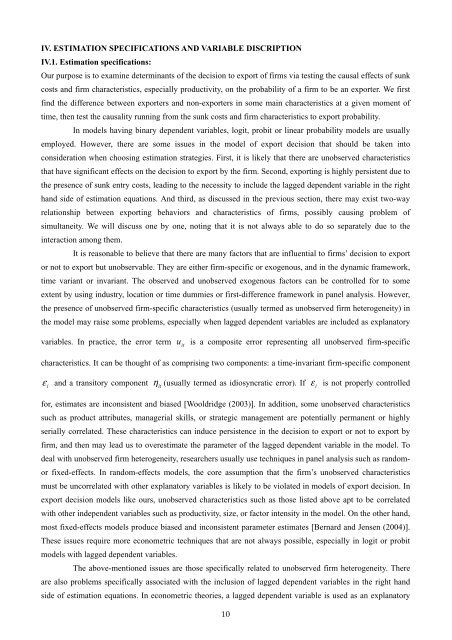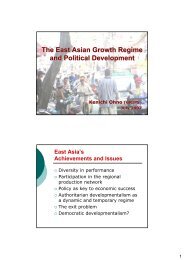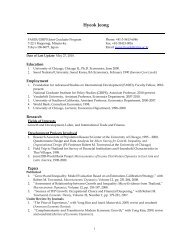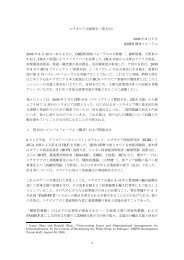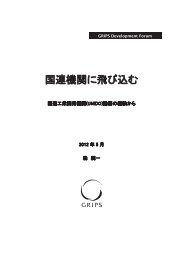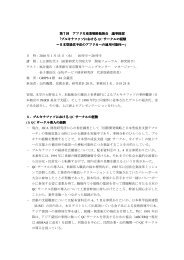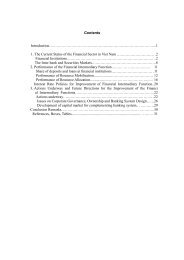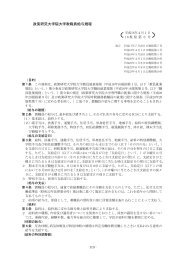Evidence from Firm-level Data in Vietnam
Evidence from Firm-level Data in Vietnam
Evidence from Firm-level Data in Vietnam
You also want an ePaper? Increase the reach of your titles
YUMPU automatically turns print PDFs into web optimized ePapers that Google loves.
IV. ESTIMATION SPECIFICATIONS AND VARIABLE DISCRIPTIONIV.1. Estimation specifications:Our purpose is to exam<strong>in</strong>e determ<strong>in</strong>ants of the decision to export of firms via test<strong>in</strong>g the causal effects of sunkcosts and firm characteristics, especially productivity, on the probability of a firm to be an exporter. We firstf<strong>in</strong>d the difference between exporters and non-exporters <strong>in</strong> some ma<strong>in</strong> characteristics at a given moment oftime, then test the causality runn<strong>in</strong>g <strong>from</strong> the sunk costs and firm characteristics to export probability.In models hav<strong>in</strong>g b<strong>in</strong>ary dependent variables, logit, probit or l<strong>in</strong>ear probability models are usuallyemployed. However, there are some issues <strong>in</strong> the model of export decision that should be taken <strong>in</strong>toconsideration when choos<strong>in</strong>g estimation strategies. First, it is likely that there are unobserved characteristicsthat have significant effects on the decision to export by the firm. Second, export<strong>in</strong>g is highly persistent due tothe presence of sunk entry costs, lead<strong>in</strong>g to the necessity to <strong>in</strong>clude the lagged dependent variable <strong>in</strong> the righthand side of estimation equations. And third, as discussed <strong>in</strong> the previous section, there may exist two-wayrelationship between export<strong>in</strong>g behaviors and characteristics of firms, possibly caus<strong>in</strong>g problem ofsimultaneity. We will discuss one by one, not<strong>in</strong>g that it is not always able to do so separately due to the<strong>in</strong>teraction among them.It is reasonable to believe that there are many factors that are <strong>in</strong>fluential to firms’ decision to exportor not to export but unobservable. They are either firm-specific or exogenous, and <strong>in</strong> the dynamic framework,time variant or <strong>in</strong>variant. The observed and unobserved exogenous factors can be controlled for to someextent by us<strong>in</strong>g <strong>in</strong>dustry, location or time dummies or first-difference framework <strong>in</strong> panel analysis. However,the presence of unobserved firm-specific characteristics (usually termed as unobserved firm heterogeneity) <strong>in</strong>the model may raise some proble ms, especially when lagged dependent variables are <strong>in</strong>cluded as explanatoryvariables. In practice, the error term u itis a composite error represent<strong>in</strong>g all unobserved firm-specificcharacteristics. It can be thought of as compris<strong>in</strong>g two components: a time-<strong>in</strong>variant firm-specific componentεiand a transitory componentηit(usually termed as idiosyncratic error). Ifεiis not properly controlledfor, estimates are <strong>in</strong>consistent and biased [Wooldridge (2003)]. In addition, some unobserved characteristicssuch as product attributes, managerial skills, or strategic management are potentially permanent or highlyserially correlated. These characteristics can <strong>in</strong>duce persistence <strong>in</strong> the decision to export or not to export byfirm, and then may lead us to overestimate the parameter of the lagged dependent variable <strong>in</strong> the model. Todeal with unobserved firm heterogeneity, researchers usually use techniques <strong>in</strong> panel analysis such as randomorfixed-effects. In random-effects models, the core assumption that the firm’s unobserved characteristicsmust be uncorrelated with other explanatory variables is likely to be violated <strong>in</strong> models of export decision. Inexport decision models like ours, unobserved characteristics such as those listed above apt to be correlatedwith other <strong>in</strong>dependent variables such as productivity, size, or factor <strong>in</strong>tensity <strong>in</strong> the model. On the other hand,most fixed-effects models produce biased and <strong>in</strong>consistent parameter estimates [Bernard and Jensen (2004)].These issues require more econometric techniques that are not always possible, especially <strong>in</strong> logit or probitmodels with lagged dependent variables.The above-mentioned issues are those specifically related to unobserved firm heterogeneity. Thereare also problems specifically associated with the <strong>in</strong>clusion of lagged dependent variables <strong>in</strong> the right handside of estimation equations. In econometric theories, a lagged dependent variable is used as an explanatory10


